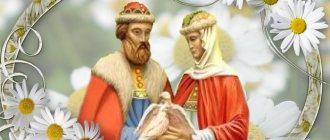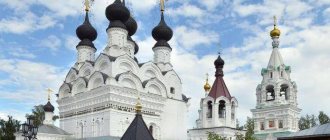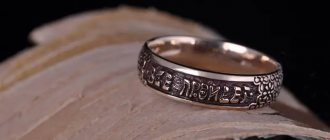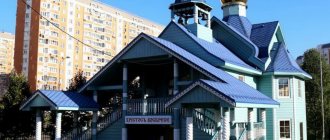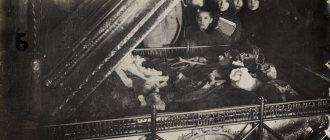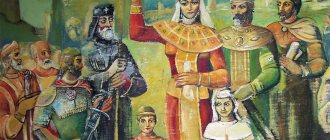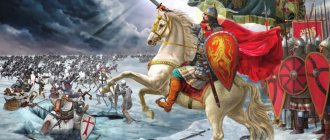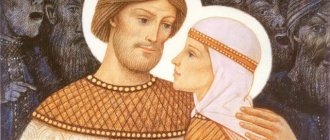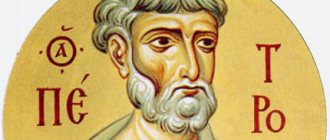Life of Saints Peter and Fevronia
Information about Peter and Fevronia is known to us from the “ Tale of Peter and Fevronia of Murom ” - one of the peaks of ancient Russian literature of the 16th century. Its compiler in connection with the canonization of Peter and Fevronia by order of Metropolitan Macarius (c. 1482 - 1563) was the monk Ermolai-Erasmus (1500s - mid-16th century). According to the Tale, several years before his reign, Peter killed the fiery serpent, but from the serpent’s blood he fell ill with leprosy, from which no one could cure him. It was revealed to the prince in a dream that he could be healed by the daughter of a “tree-dweller” (beekeeper) who extracted wild honey, Fevronia, a peasant woman from the village of Laskovo, Ryazan land. Fevronia, as payment for the treatment, wished that the prince would marry her after the healing, and the prince made a promise to marry her. Fevronia healed Peter, but he did not keep his word, since Fevronia was a commoner. But during the treatment process, Fevronia deliberately did not heal one scab on the prince’s body, which is why the disease recurred; Fevronia cured Peter again, and he was forced to marry her. When Peter inherited the reign after his brother, the boyars did not want to have a princess of simple rank, telling him: “Either let go of your wife, who insults noble ladies with her origin, or leave her as Murom.” The prince took Fevronia, and on two ships they sailed along the Oka. After this, unrest began in Murom, many began to illegally lay claim to the vacated throne, and murders began. Then the boyars asked the prince and his wife to return. The prince and princess returned, and Fevronia subsequently managed to earn the love of the townspeople. In old age, having taken monastic vows in different monasteries with the names David and Euphrosyne, they prayed to God that they would die on the same day, and bequeathed their bodies to be placed in one coffin, having previously prepared a tomb of one stone, with a thin partition. They died on the same day and hour. Considering burial in the same coffin incompatible with the monastic rank, their bodies were placed in different monasteries, but the next day they found themselves together.
Peter's story
According to legend, in ancient times Murom was ruled by Prince Pavel. He had a beautiful wife, who began to be disturbed by a winged serpent. It was the devil, who fiercely hated the entire human race, who sent his faithful servant to discredit the princess. The serpent, taking the guise of a prince, captured an honest woman by cunning.
Having learned about this, the annoyed prince ordered his wife to find out the secret of his death from the insidious serpent. The princess learned that death was prepared for the tempter at the sword of Petrov and Agrikov. Prince Pavel told his brother Peter about this, and he immediately decided that he would be the one to fight the servant of darkness.
All that remains is to find Agrikov's sword. Peter accidentally found it in the monastery, in the Church of the Exaltation of the Precious and Life-Giving Cross of the Lord, where he loved to pray. Taking Agrikov's sword, Peter went to the princess's chambers and defeated the snake.
The devil's servant died, splashing Peter with his poisonous blood. As a result, the young prince was covered with fetid scabs and ulcers, which no doctor could cure.
Veneration of Saints Peter and Fevronia
The day of church veneration of Saints Peter and Fevronia is July 8 (June 25, old style). The indication in the chronicles that the death of Prince David and Princess Euphrosyne and their burial fell on Bright Week 1228 raises a dispute about the discrepancy between the time of death and the date of church veneration. According to church liturgical tradition, there are two occasions for commemorating saints - on the day of their death and on the day of the transfer of their holy relics. The “Tale” clearly refers to the date of death:
...the saints gave up their soul together in the hand of God on the 25th day of the month of June.
It has been suggested that the date June 25, the day of the Holy Martyr Fevronia of Syria, is associated with the transfer of the relics of the holy prince and princess from the dilapidated Boris and Gleb Cathedral to the recently renovated Cathedral of the Nativity of the Virgin Mary on Voivodskaya Mountain, where the relics were located until Soviet times. The cathedral was demolished in the late 1930s. The holy spouses were buried in the cathedral church of the city of Murom in honor of the Nativity of the Blessed Virgin Mary, erected over their relics according to a vow by Tsar Ivan the Terrible in 1553. After the establishment of Soviet power, in 1921, the relics were taken to a local museum, where they were put on public display. Since 1992, the relics have rested openly in the cathedral church of the Holy Trinity Monastery in Murom.
Library of the Russian Faith Canon to Saints Peter and Fevronia →
Read online
Treacherous boyars
Soon Prince Pavel died, and Peter took his throne. Fevronia continued to show miracles. For example, in her hands, crumbs from the table after a meal turned into incense.
However, the Murom boyars did not like the common princess, whose father made a living by climbing trees and collecting wild honey. They were ashamed that a woman of such low rank became the wife of their ruler. They asked Peter to divorce Fevronia and take a princess from the nobility.
During the feast, the drunken boyars began to say nasty things to her and asked her to leave the city, leaving Peter. And if he refuses, then he will be driven out of Murom.
Troparion, Kontakion and Canon to Saints Peter and Fevronia
Troparion, tone 8
Just as you were of a pious and most honorable nature, having lived well in piety, blessed Peter, so with your wife, the wise Fevronia, you pleased God in the world, and were honored with the life of the venerables; With them, pray to the Lord to preserve your Fatherland without harm, and let us honor you unceasingly.
Kontakion, tone 8
The reign and glory of this world, as if temporarily thinking, and for this sake you lived piously in the world of Peter, together with your wise wife Fevronia, pleasing God with alms and prayers; In the same way, even after death, lying inseparably in the tomb, you invisibly give healing, and now you pray to Christ to save the city and the people who glorify you.
Wanderings along the Oka
But the prince decided to stay with his wife. Both sailed away from the city on boats along the river.
One of the people sailing on the same ship with the princess, tempted by a demon, decided to sin with Fevronia. At the same time, the man’s wife swam next to them.
But the princess understood what this man was up to. She ordered him to drink water from the Oka from the starboard side and from the left. And she asked, how is the water different? He replied that nothing. So my feminine nature, said Fevronia, is no different from the nature of your wife. The sinner was ashamed and no longer dared to indulge in such thoughts.
And at one of the sites on the shore, their cook cut down young trees to hang cauldrons. Fevronia blessed these stumps, and in the morning they became trees again.
Saints Peter and Fevronia. Icons
On the icons, Saints Peter and Fevronia are depicted in full growth, in monastic vestments. A cross or scroll is depicted in the hands of Peter and Fevronia.
Pankraty of Tavromenia, Peter and Fevronia of Murom. Double-sided icon-tablet, reverse - Saints Constantine and Helen. Second half of the 16th century, Novgorod. Veliky Novgorod, Novgorod State. historical, architectural and art museum-reserve
|
|
Savior Almighty with the saints. In the middle in the bottom row in the center are depicted the martyrs Kirik and Iulita, on the left are St. Basil the Great and the blessed Prince Peter of Murom, on the right are the Apostle Herodion and the Monk Paisius the Great. In the top row on the left are the blessed princess Fevronia, the martyrs Catherine, Paraskeva Pyatnitsa, on the right are the martyrs Evdokia, Alexandra and the Venerable Mary of Egypt. Moscow, second half of the 19th century. Moscow, Central Museum of Ancient Russian Culture and Art named after. Andrey Rublev
The cover with the image of Saints Peter and Fevronia is a contribution to the Nativity of the Virgin Mary Cathedral of Tsar Theodore and Tsarina Irina. Made in the Tsarina's workshop in 1593
Saints Prince Peter and Princess Fevronia of Murom, with their lives. 1618 Murom Historical and Art Museum, Murom
Temples in honor of Saints Peter and Fevronia
In honor of Saints Peter and Fevronia, the chapel of the Cathedral of the Nativity of the Blessed Virgin Mary in the city of Murom (1555-1557) was consecrated. There are three altars on the top floor of the temple: the main one in honor of the Nativity of the Blessed Virgin Mary, in the chapels in the name of St. Apostles Peter and Paul and in the name of St. Alexis, man of God and Mary Magdalene; on the lower floor in the name of the Murom miracle workers - the blessed Prince Peter and Princess Fevronia. The main cathedral of Murom stood in the center of the Kremlin on Voevodskaya Mountain. According to church historian Professor E. Golubinsky , the first temple on this site was built in the pre-Mongol period. The Cathedral of the Nativity of the Virgin Mary witnessed many dramatic events in the history of ancient Murom. During the XIII-XIV centuries, it, together with the city, was repeatedly subjected to Tatar devastation. The cathedral was dismantled before the Great Patriotic War.
Cathedral of the Nativity of the Blessed Virgin Mary in Murom
In honor of Saints Peter and Fevronia, the chapel of the Cathedral of the Most Holy Trinity of the Trinity Convent in Murom, Vladimir Region, was consecrated. The monastery was founded in the second quarter of the 17th century by the Murom merchant Tarasy Borisovich Tsvetnov, according to a number of local historians, on the site of the so-called “old settlement”, where initially in the period of the 11th-13th centuries there was a wooden cathedral in honor of Saints Boris and Gleb, and later existed wooden Holy Trinity Church. In 1642-1643, through the efforts of Tarasy Tsvetnov, the Holy Trinity Stone Cathedral was erected on the site of a wooden church, which has survived to this day.
In honor of Saints Peter and Fevronia, an Old Believer Church (ROC) is being built in the city of Murom, Vladimir Region.
Saint Constantine
According to legend, in the 12th century, the baptizer of the land of Murom was the blessed Prince Constantine, who began to build the first Orthodox churches here. He is mentioned in “The Tale of the Establishment of Christianity in Murom” as the builder of the original Church of the Annunciation of the Blessed Virgin Mary.
The iconography of Saint Constantine is dedicated to the prince and his two sons - Michael and Feodor, who are always depicted together in spiritual and prayerful union in the Holy Trinity of the Consubstantial. Thus, the motive of comparing the holy couple with Her can be traced.
In the Vyshny settlement, Prince Konstantin later built the Boris and Gleb Church, which later, or rather five hundred years later, turned into the monastery of the Holy Trinity.
Day of Family, Love and Fidelity
The Russian Orthodox Church has established a special day for the veneration of saints - the day of Peter and Fevronia. In 2006, on the initiative of the city authorities, residents of Murom collected 15-20 thousand signatures under an appeal about the “ All-Russian Day of Married Love and Family Happiness (in memory of the blessed princes Peter and Fevronia of Murom) ,” which called for declaring July 8 an all-Russian holiday dedicated to moral and spiritual family values. The all-Russian holiday, called “ Day of Family, Love and Fidelity ,” was first held on July 8, 2008. Due to the fact that the day of memory of Peter and Fevronia falls on Peter's Fast, when the sacrament of marriage is not performed, the Synod of the Russian Orthodox Church on December 25, 2012 established a second celebration in memory of the transfer of relics, which took place in 1992. The celebration takes place on the Sunday preceding September 6 (19).
Sculptures of Saints Peter and Fevronia
In the 21st century, monuments to Peter and Fevronia appeared in many Russian cities. Sculptural compositions “ Holy Saints Peter and Fevronia of Murom ” began to be installed in Russian cities in 2009 as part of the national program “In the Family Circle,” created with the blessing of Patriarch Alexy II of Moscow and All Russia (ROC). Sculptures of Saints Peter and Fevronia are installed in cities such as Murom, Arkhangelsk, Sochi, Ulyanovsk, Yaroslavl, Abakan, Nizhny Tagil, Yeisk, Blagoveshchensk, Omsk, Samara, Vladivostok, Irkutsk, Rostov-on-Don, Novosibirsk, Izhevsk, Tambov, Tula, Klin, Volgograd, Kirov, Veliky Novgorod, Krasnoyarsk, Podolsk, Obninsk, Sergiev Posad, Volchansk, Voronezh, St. Petersburg, Nizhny Novgorod, Khabarovsk, Astrakhan and many others.
Monument to Saints Peter and Fevronia in Murom
Monument to Saints Peter and Fevronia in Yaroslavl
Monument to Saints Peter and Fevronia in Rostov-on-Don
Monument to Saints Peter and Fevronia in Obninsk
Wonderful sourdough
Fevronia gave the prince leaven, a bath was heated, in which Peter smeared all the scabs with this potion. In the morning, all the ulcers except one were gone, and he felt healthy. But he didn’t want to get married.
Peter sent the girl gifts, but she refused them. Then Peter went home to Murom. And from one ulcer, others multiplied throughout the body and the prince fell ill again.
Peter returned to Fevronia and vowed to marry. She again cured the Murom resident, who, after healing, took the girl as his wife.
Folk traditions on the day of Saints Peter and Fevronia
For a long time, spouses turned to the Murom prince Peter and his wife Fevronia with prayers for family happiness. This day was happy for love and marriage, and after the Kupala games on the previous day, betrothed couples were determined. According to popular beliefs, happy marriages take place on this day. From that day on, they swam without looking back, since it was believed that on this day the last mermaids leave the shores deep into the reservoirs and fall asleep. This day was also considered the day of full maturity of field and forest grasses, blooming by this time in all their glory.
Fevronia
Peter sent messengers to the Ryazan lands, which were famous for their folk healers. In the village of Laskovo, one of the messengers met a young girl named Fevronia, who had the reputation of a skilled healer.
The girl promised to cure Peter of his illness if he took her as his wife. Having received the prince's consent, Fevronia prepared medicine from sourdough bread and ordered Peter to lubricate the sick body so that only one scab remained ungreased.
The illness immediately subsided, but the prince did not even think about keeping his word and marrying a commoner. Very quickly, Peter’s body was again covered with ulcers. He had no choice but to fulfill his promise and marry Fevronia.
Saints Peter and Fevronia. Art
St. Petersburg artist A. E. Prostev created a series of works dedicated to the life of Peter and Fevronia of Murom.
A.V. Prostev. What God has joined together, let no man separate. 2008
A.V. Prostev. Peter and Fevronia. The prince and the peasant woman. 2008
A.V. Prostev. Sacrament of wedding. 2008
The Tale of Peter and Fevronia was released . The film is based on the Tale of the Murom Saints Peter and Fevronia.
Real facts
Real historical characters, later canonized by the church as Saints Peter and Fevronia, are Prince Davyd Yuryevich of Murom and his wife. Little is known about the prince’s wife, but he himself ascended the throne in Murom after his older brother Vladimir. Davyd Yuryevich was a supporter of Grand Duke Vsevolod the Big Nest and fought on his side in all significant battles of that period.
In 1208, Vsevolod the Big Nest gave the city of Pronsk to Davyd Yuryevich, who had taken it from the previous prince Oleg for misconduct. However, in the same year, Oleg gathered his brothers and drove Davyd Yuryevich out of the city.
After Vsevolod the Big Nest died, Prince Davyd began to support his sons Yuri and Yaroslav and participate in the campaigns they organized.
Peter and Fevronia with an angel
If you believe the chronicles, Prince Davyd became a monk and died on the same day as his youngest son Svyatoslav, on Easter 1228. There is no evidence in the chronicles that the prince’s wife also became a nun, or about the day of her death. However, church tradition claims that the prince and princess died on the same day.
Whether the legendary Peter and Fevronia had children is unknown. The real-life Prince of Murom, Davyd Yuryevich, had two sons - Yuri and Svyatoslav, and a daughter, Evdokia.
